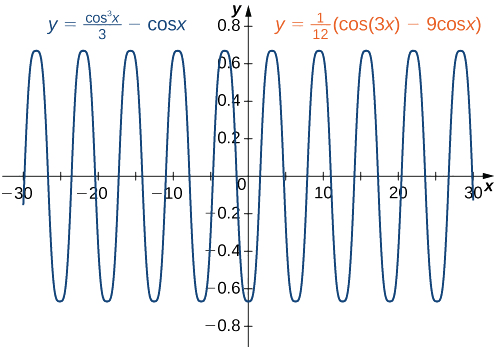7.5: Other Strategies for Integration
- Page ID
- 2552
\( \newcommand{\vecs}[1]{\overset { \scriptstyle \rightharpoonup} {\mathbf{#1}} } \)
\( \newcommand{\vecd}[1]{\overset{-\!-\!\rightharpoonup}{\vphantom{a}\smash {#1}}} \)
\( \newcommand{\dsum}{\displaystyle\sum\limits} \)
\( \newcommand{\dint}{\displaystyle\int\limits} \)
\( \newcommand{\dlim}{\displaystyle\lim\limits} \)
\( \newcommand{\id}{\mathrm{id}}\) \( \newcommand{\Span}{\mathrm{span}}\)
( \newcommand{\kernel}{\mathrm{null}\,}\) \( \newcommand{\range}{\mathrm{range}\,}\)
\( \newcommand{\RealPart}{\mathrm{Re}}\) \( \newcommand{\ImaginaryPart}{\mathrm{Im}}\)
\( \newcommand{\Argument}{\mathrm{Arg}}\) \( \newcommand{\norm}[1]{\| #1 \|}\)
\( \newcommand{\inner}[2]{\langle #1, #2 \rangle}\)
\( \newcommand{\Span}{\mathrm{span}}\)
\( \newcommand{\id}{\mathrm{id}}\)
\( \newcommand{\Span}{\mathrm{span}}\)
\( \newcommand{\kernel}{\mathrm{null}\,}\)
\( \newcommand{\range}{\mathrm{range}\,}\)
\( \newcommand{\RealPart}{\mathrm{Re}}\)
\( \newcommand{\ImaginaryPart}{\mathrm{Im}}\)
\( \newcommand{\Argument}{\mathrm{Arg}}\)
\( \newcommand{\norm}[1]{\| #1 \|}\)
\( \newcommand{\inner}[2]{\langle #1, #2 \rangle}\)
\( \newcommand{\Span}{\mathrm{span}}\) \( \newcommand{\AA}{\unicode[.8,0]{x212B}}\)
\( \newcommand{\vectorA}[1]{\vec{#1}} % arrow\)
\( \newcommand{\vectorAt}[1]{\vec{\text{#1}}} % arrow\)
\( \newcommand{\vectorB}[1]{\overset { \scriptstyle \rightharpoonup} {\mathbf{#1}} } \)
\( \newcommand{\vectorC}[1]{\textbf{#1}} \)
\( \newcommand{\vectorD}[1]{\overrightarrow{#1}} \)
\( \newcommand{\vectorDt}[1]{\overrightarrow{\text{#1}}} \)
\( \newcommand{\vectE}[1]{\overset{-\!-\!\rightharpoonup}{\vphantom{a}\smash{\mathbf {#1}}}} \)
\( \newcommand{\vecs}[1]{\overset { \scriptstyle \rightharpoonup} {\mathbf{#1}} } \)
\( \newcommand{\vecd}[1]{\overset{-\!-\!\rightharpoonup}{\vphantom{a}\smash {#1}}} \)
\(\newcommand{\avec}{\mathbf a}\) \(\newcommand{\bvec}{\mathbf b}\) \(\newcommand{\cvec}{\mathbf c}\) \(\newcommand{\dvec}{\mathbf d}\) \(\newcommand{\dtil}{\widetilde{\mathbf d}}\) \(\newcommand{\evec}{\mathbf e}\) \(\newcommand{\fvec}{\mathbf f}\) \(\newcommand{\nvec}{\mathbf n}\) \(\newcommand{\pvec}{\mathbf p}\) \(\newcommand{\qvec}{\mathbf q}\) \(\newcommand{\svec}{\mathbf s}\) \(\newcommand{\tvec}{\mathbf t}\) \(\newcommand{\uvec}{\mathbf u}\) \(\newcommand{\vvec}{\mathbf v}\) \(\newcommand{\wvec}{\mathbf w}\) \(\newcommand{\xvec}{\mathbf x}\) \(\newcommand{\yvec}{\mathbf y}\) \(\newcommand{\zvec}{\mathbf z}\) \(\newcommand{\rvec}{\mathbf r}\) \(\newcommand{\mvec}{\mathbf m}\) \(\newcommand{\zerovec}{\mathbf 0}\) \(\newcommand{\onevec}{\mathbf 1}\) \(\newcommand{\real}{\mathbb R}\) \(\newcommand{\twovec}[2]{\left[\begin{array}{r}#1 \\ #2 \end{array}\right]}\) \(\newcommand{\ctwovec}[2]{\left[\begin{array}{c}#1 \\ #2 \end{array}\right]}\) \(\newcommand{\threevec}[3]{\left[\begin{array}{r}#1 \\ #2 \\ #3 \end{array}\right]}\) \(\newcommand{\cthreevec}[3]{\left[\begin{array}{c}#1 \\ #2 \\ #3 \end{array}\right]}\) \(\newcommand{\fourvec}[4]{\left[\begin{array}{r}#1 \\ #2 \\ #3 \\ #4 \end{array}\right]}\) \(\newcommand{\cfourvec}[4]{\left[\begin{array}{c}#1 \\ #2 \\ #3 \\ #4 \end{array}\right]}\) \(\newcommand{\fivevec}[5]{\left[\begin{array}{r}#1 \\ #2 \\ #3 \\ #4 \\ #5 \\ \end{array}\right]}\) \(\newcommand{\cfivevec}[5]{\left[\begin{array}{c}#1 \\ #2 \\ #3 \\ #4 \\ #5 \\ \end{array}\right]}\) \(\newcommand{\mattwo}[4]{\left[\begin{array}{rr}#1 \amp #2 \\ #3 \amp #4 \\ \end{array}\right]}\) \(\newcommand{\laspan}[1]{\text{Span}\{#1\}}\) \(\newcommand{\bcal}{\cal B}\) \(\newcommand{\ccal}{\cal C}\) \(\newcommand{\scal}{\cal S}\) \(\newcommand{\wcal}{\cal W}\) \(\newcommand{\ecal}{\cal E}\) \(\newcommand{\coords}[2]{\left\{#1\right\}_{#2}}\) \(\newcommand{\gray}[1]{\color{gray}{#1}}\) \(\newcommand{\lgray}[1]{\color{lightgray}{#1}}\) \(\newcommand{\rank}{\operatorname{rank}}\) \(\newcommand{\row}{\text{Row}}\) \(\newcommand{\col}{\text{Col}}\) \(\renewcommand{\row}{\text{Row}}\) \(\newcommand{\nul}{\text{Nul}}\) \(\newcommand{\var}{\text{Var}}\) \(\newcommand{\corr}{\text{corr}}\) \(\newcommand{\len}[1]{\left|#1\right|}\) \(\newcommand{\bbar}{\overline{\bvec}}\) \(\newcommand{\bhat}{\widehat{\bvec}}\) \(\newcommand{\bperp}{\bvec^\perp}\) \(\newcommand{\xhat}{\widehat{\xvec}}\) \(\newcommand{\vhat}{\widehat{\vvec}}\) \(\newcommand{\uhat}{\widehat{\uvec}}\) \(\newcommand{\what}{\widehat{\wvec}}\) \(\newcommand{\Sighat}{\widehat{\Sigma}}\) \(\newcommand{\lt}{<}\) \(\newcommand{\gt}{>}\) \(\newcommand{\amp}{&}\) \(\definecolor{fillinmathshade}{gray}{0.9}\)- Use a table of integrals to solve integration problems.
- Use a computer algebra system (CAS) to solve integration problems.
In addition to the techniques of integration we have already seen, several other tools are widely available to assist with the process of integration. Among these tools are integration tables, which are readily available in many books, including the appendices to this one. Also widely available are computer algebra systems (CAS), which are found on calculators and in many campus computer labs, and are free online.
Tables of Integrals
Integration tables, if used in the right manner, can be a handy way either to evaluate or check an integral quickly. Keep in mind that when using a table to check an answer, it is possible for two completely correct solutions to look very different. For example, in Trigonometric Substitution, we found that, by using the substitution \(\displaystyle x=\tan θ,\) we can arrive at
\(\displaystyle ∫\frac{dx}{\sqrt{1+x^2}}=\ln \left| x+\sqrt{x^2+1}\right| +C.\)
However, using \(\displaystyle x=\sinh θ\), we obtained a different solution—namely,
\(\displaystyle ∫\frac{dx}{\sqrt{1+x^2}}=\sinh^{−1}x+C.\)
We later showed algebraically that the two solutions are equivalent. That is, we showed that \(\displaystyle \sinh^{−1}x=\ln \left| x+\sqrt{x^2+1}\right| \). In this case, the two antiderivatives that we found were actually equal. This need not be the case. However, as long as the difference in the two antiderivatives is a constant, they are equivalent.
Use the table formula
\(\displaystyle ∫\frac{\sqrt{a^2−u^2}}{u^2}du=−\frac{\sqrt{a^2−u^2}}{u}−\sin^{−1}\frac{u}{a}+C\)
to evaluate \(\displaystyle ∫\frac{\sqrt{16−e^{2x}}}{e^x}dx.\)
Solution
If we look at integration tables, we see that several formulas contain expressions of the form \(\displaystyle \sqrt{a^2−u^2}.\) This expression is actually similar to \(\displaystyle \sqrt{16−e^{2x}},\) where \(\displaystyle a=4\) and \(\displaystyle u=e^x\). Keep in mind that we must also have \(\displaystyle du=e^x\). Multiplying the numerator and the denominator of the given integral by \(\displaystyle e^x\) should help to put this integral in a useful form. Thus, we now have
\(\displaystyle ∫\frac{\sqrt{16−e^{2x}}}{e^x}dx=∫\frac{\sqrt{16−e^{2x}}}{e^{2x}}e^xdx.\)
Substituting \(\displaystyle u=e^x\) and \(\displaystyle du=e^x\,dx\) produces \(\displaystyle ∫\frac{\sqrt{a^2−u^2}}{u^2}du.\) From the integration table (#88 in Appendix A),
\(\displaystyle ∫\frac{\sqrt{a^2−u^2}}{u^2}du=−\frac{\sqrt{a^2−u^2}}{u}−\sin^{−1}\frac{u}{a}+C.\)
Thus,
\(\displaystyle ∫\frac{\sqrt{16−e^{2x}}}{e^x}dx=∫\frac{\sqrt{16−e^{2x}}}{e^{2x}}e^xdx\) Substitute \(\displaystyle u=e^x\) and \(\displaystyle du=e^xdx.\)
\(\displaystyle =∫\frac{\sqrt{4^2−u^2}}{u^2}du\) Apply the formula using \(\displaystyle a=4\).
\(\displaystyle =−\frac{\sqrt{4^2−u^2}}{u}−\sin^{−1}\frac{u}{4}+C\) Substitute \(\displaystyle u=e^x\).
\(\displaystyle =−\frac{\sqrt{16−e^{2x}}}{e^x}−\sin^{−1}(\frac{e^x}{4})+C\)
Computer Algebra Systems
If available, a CAS is a faster alternative to a table for solving an integration problem. Many such systems are widely available and are, in general, quite easy to use.
Use a computer algebra system to evaluate \(\displaystyle ∫\frac{dx}{\sqrt{x^2−4}}.\) Compare this result with \(\displaystyle \ln \left| \frac{\sqrt{x^2−4}}{2}+\frac{x}{2}\right| +C,\) a result we might have obtained if we had used trigonometric substitution.
Solution
Using Wolfram Alpha, we obtain
\(\displaystyle ∫\frac{dx}{\sqrt{x^2−4}}=\ln \left|\sqrt{x^2−4}+x\right| +C.\)
Notice that
\(\displaystyle \ln \left|\frac{\sqrt{x^2−4}}{2}+\frac{x}{2}\right| +C=\ln \left|\frac{\sqrt{x^2−4}+x}{2}\right| +C=\ln \left|\sqrt{x^2−4}+x\right| −\ln 2+C.\)
Since these two antiderivatives differ by only a constant, the solutions are equivalent. We could have also demonstrated that each of these antiderivatives is correct by differentiating them.
You can access an integral calculator for more examples.
Evaluate \(\displaystyle ∫ \sin^3x\,dx\) using a CAS. Compare the result to \(\displaystyle \frac{1}{3}\cos^3x−\cos x+C\), the result we might have obtained using the technique for integrating odd powers of \(\displaystyle \sin x\) discussed earlier in this chapter.
Solution
Using Wolfram Alpha, we obtain
\(\displaystyle ∫\sin^3x\,dx=\frac{1}{12}(\cos(3x)−9\cos x)+C.\)
This looks quite different from \(\displaystyle \frac{1}{3}\cos^3x−\cos x+C.\) To see that these antiderivatives are equivalent, we can make use of a few trigonometric identities:
\(\displaystyle \frac{1}{12}(\cos(3x)−9\cos x)=\frac{1}{12}(\cos(x+2x)−9\cos x)\)
\(\displaystyle =\frac{1}{12}(\cos(x)\cos(2x)−\sin(x)\sin(2x)−9\cos x)\)
\(\displaystyle =\frac{1}{12}(\cos x(2\cos^2x−1)−\sin x(2\sin x \cos x)−9\cos x)\)
\(\displaystyle =\frac{1}{12}(2\cos^3x−\cos x−2\cos x(1−\cos^2x)−9\cos x)\)
\(\displaystyle =\frac{1}{12}(4\cos^3x−12\cos x)\)
\(\displaystyle =\frac{1}{3}\cos^3x−\cos x.\)
Thus, the two antiderivatives are identical.
We may also use a CAS to compare the graphs of the two functions, as shown in the following figure.

Use a CAS to evaluate \(\displaystyle ∫\frac{dx}{\sqrt{x^2+4}}\).
- Hint
-
Answers may vary.
- Answer
-
Possible solutions include \(\displaystyle \sinh^{−1}\left(\frac{x}{2}\right) +C\) and \(\displaystyle \ln\left|\sqrt{x^2+4}+x\right| +C.\)
Key Concepts
- An integration table may be used to evaluate indefinite integrals.
- A CAS (or computer algebra system) may be used to evaluate indefinite integrals.
- It may require some effort to reconcile equivalent solutions obtained using different methods.
Glossary
- computer algebra system (CAS)
- technology used to perform many mathematical tasks, including integration
- integration table
- a table that lists integration formulas


